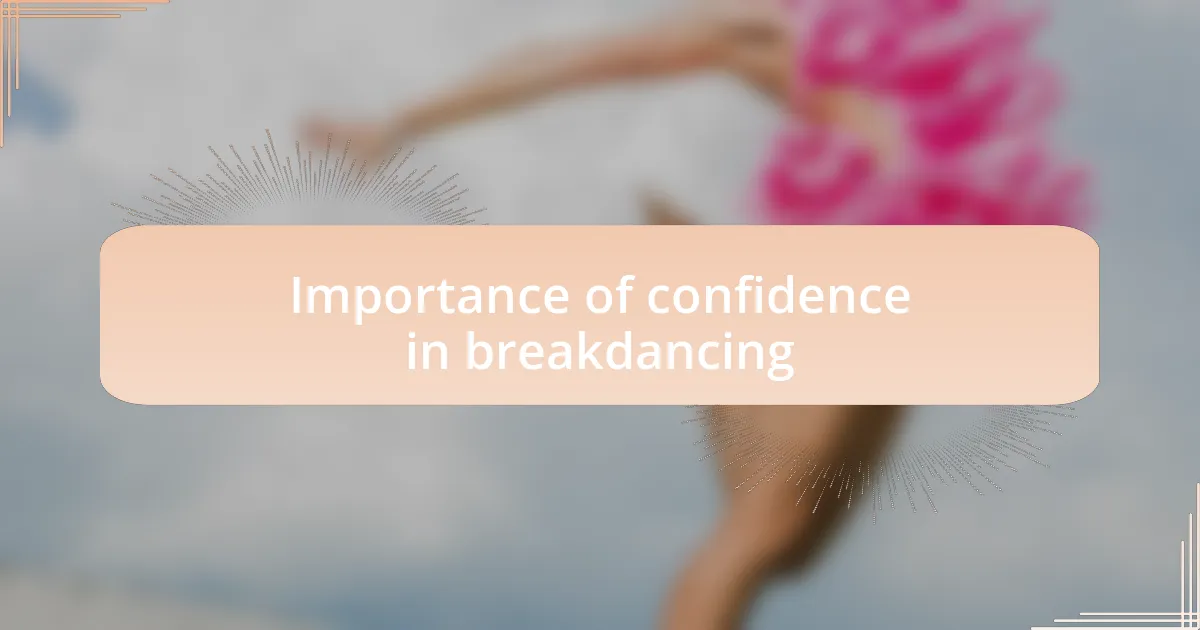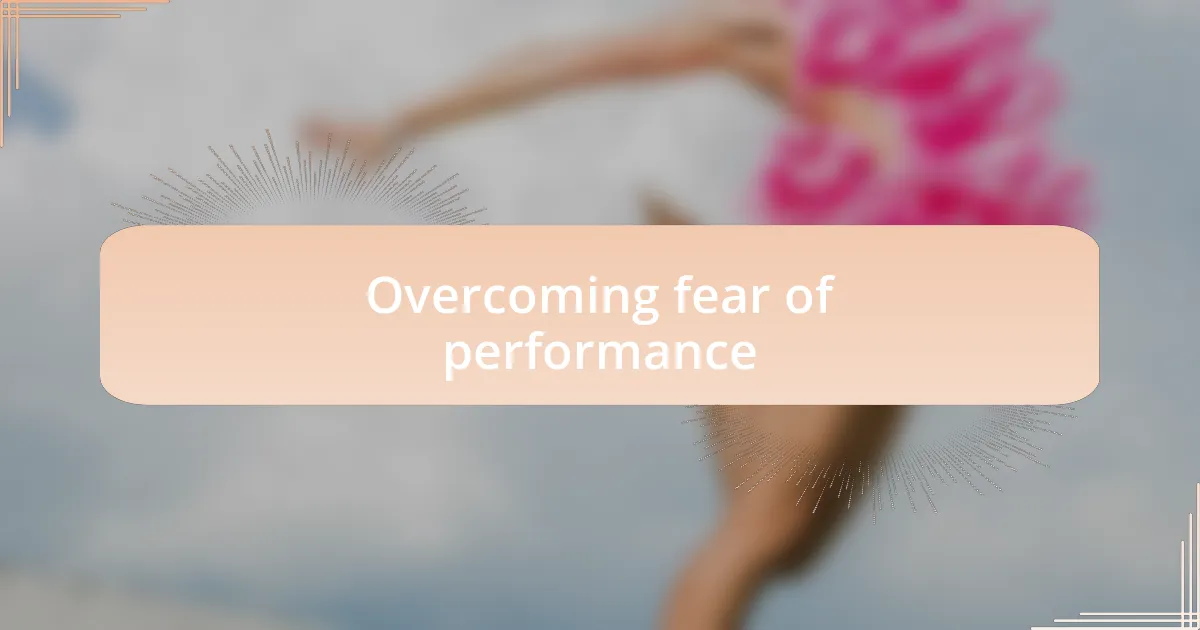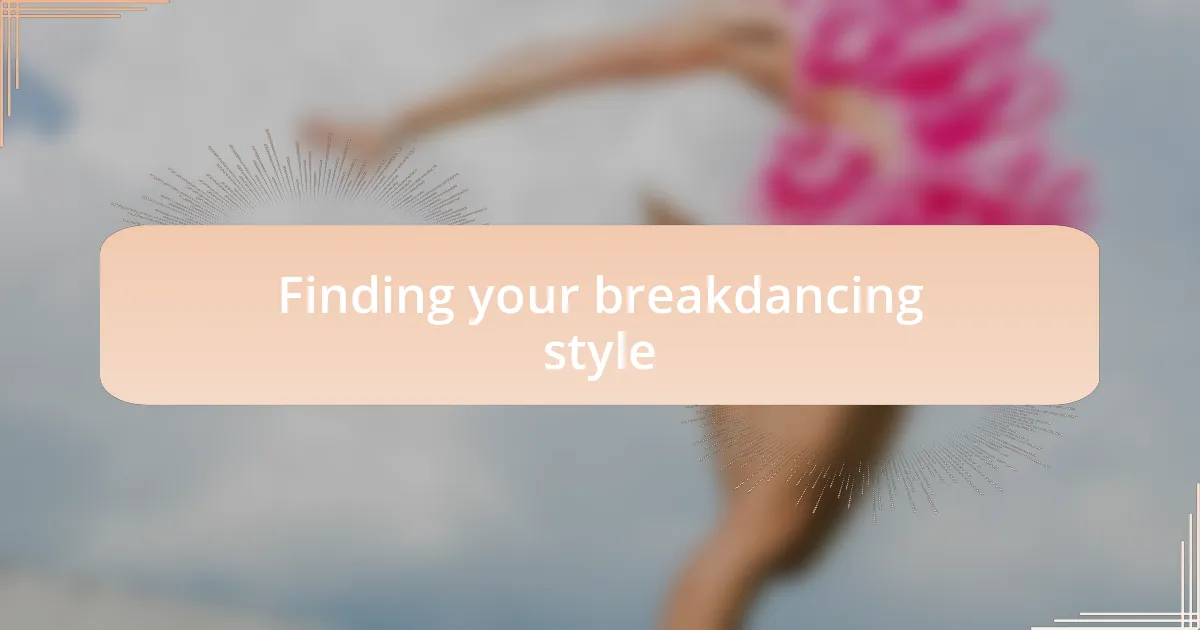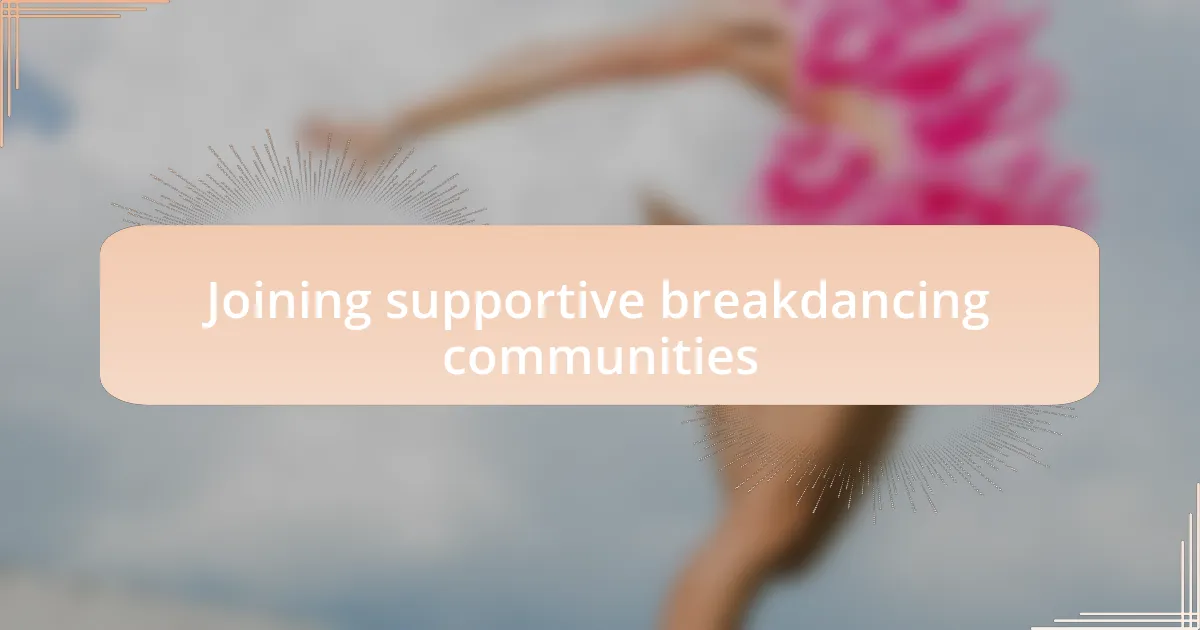Key takeaways:
- Building confidence in breakdancing involves self-acceptance, positive feedback, and embracing personal experiences.
- Practicing consistently helps develop both technical skills and personal style, leading to breakthroughs and enhanced confidence.
- Setting realistic goals and celebrating small victories can motivate dancers and make progress more tangible.
- Being part of a supportive breakdancing community fosters encouragement and collaboration, significantly boosting confidence and growth.

Understanding breakdancing confidence
Confidence in breakdancing is more than just nailing a routine; it’s about embracing your unique style and presence in the cypher. I remember the first time I stepped into a jam, my heart raced as I watched the incredible talent around me. It made me wonder: how did those b-boys and b-girls find the courage to showcase their skills so boldly?
Building confidence is a journey, and it often starts with self-acceptance. I’ve seen dancers in the community struggle with doubt, even when they possess undeniable talent. It was during a practice session that I realized how powerful positive feedback could be; a kind word from a fellow breakdancer can transform your mindset and fuel your motivation.
Moreover, confidence grows through experience and perseverance. Each battle, win or lose, teaches something new. I still remember losing a heated battle but walking away with more grit and determination; it was a defining moment that shaped my resilience. How many times have you faced setbacks in your breakdancing journey? Embracing those moments can truly cultivate a deeper sense of self-assuredness.

Importance of confidence in breakdancing
Confidence is crucial in breakdancing because it allows you to express yourself authentically. During one particularly intense battle, I felt a wave of self-doubt, but when I centered myself and embraced my unique moves, everything changed. That moment taught me how important it is to believe in your abilities, as confidence is the key that unlocks your true potential on the dance floor.
Consider this: when you exude confidence, it not only impacts your performance but also influences the energy in the room. I vividly recall a time when I was up against a skilled opponent; the way I carried myself made all the difference. The audience can sense confidence, and it often sways their perception. Have you ever noticed how the most memorable battles are those where the dancers radiate self-assuredness? There’s something magnetic about a dancer who owns their space.
Confidence acts as a protective shield during battles, helping you manage the pressure that comes with competition. I remember feeling nervous as I prepared to face an experienced dancer, but by focusing on my strengths and recalling my practice sessions, I found calm amidst the chaos. How have you navigated similar moments? Embracing your journey and the lessons learned along the way can transform anxiety into powerful energy, propelling you forward in every performance.

Building skill through practice
Building skill through consistent practice is at the heart of becoming a better breakdancer. I recall spending countless evenings in my garage, the floor covered with patches of sweat and sheer determination. Each session was a test of will, but with every move I mastered, I felt that familiar rush of pride swelling within me. Isn’t it amazing how repetition can morph hesitance into fluidity?
As I immersed myself in intricate footwork and dynamic freezes, I learned that practice isn’t just about perfecting moves; it’s also about building muscle memory and confidence. There were times when I felt like I was stuck in a rut, especially with a complicated spin that just wouldn’t click. I remember taking a step back and focusing solely on those movements, slowly breaking them down until the flow started to feel natural. Have you ever had a breakthrough moment after feeling stuck?
Moreover, each practice session was an opportunity to develop my personal style and find what truly resonated with me. Trying out different combinations, I often surprised myself with new creative ideas. The beauty of practice is that it not only sharpens your technical skills but also helps you discover your voice as a dancer. What if your next breakthrough is just a practice session away? Embracing the journey often leads to unexpected milestones.

Overcoming fear of performance
Standing on stage, I often found my heart racing and palms sweating. That moment before a performance can feel overwhelming, filled with self-doubt. I remember grappling with that fear, realizing it was more about my mindset than my skills. The simple act of acknowledging my nerves helped me turn that anxiety into excitement instead. Have you ever noticed how your feelings can shift when you confront them head-on?
Many times, I would rehearse in front of friends who were not dancers, which felt terrifying at first. However, this exposure taught me to focus less on perfection and more on the joy of expressing myself. I learned that every cringeworthy moment during practice only made me more resilient for the real deal. The audience isn’t there to judge; they’re there to witness my passion. How liberating is it to remember that even seasoned dancers face those same jitters?
One effective strategy I found was visualizing my performance before stepping onto the floor. Picture this: I close my eyes, imagining each move flowing effortlessly, the crowd cheering in response. This mental preparation ingrained a sense of confidence that transcended the physical aspects of the dance. By the time I was ready to perform, I was not just dancing; I was sharing a piece of myself. What if visualization became your secret weapon against performance anxiety?

Setting realistic breakdancing goals
Setting realistic breakdancing goals can make a world of difference in your journey. Early on, I used to dream big—landing the craziest power moves right out of the gate. But after a few bruises and countless stumbles, I realized that breaking my goals down into achievable milestones was the way to go. For instance, focusing on mastering six-step transitions before diving into windmills felt more manageable and rewarding.
One weekend, I decided to set a goal of learning just one new move each week. I was excited but also apprehensive. I remember nailing a basic flare after what felt like endless attempts, and that small victory fueled my motivation. There’s something magical about celebrating those little wins; they remind you that progress isn’t always about leaps but often about steady, deliberate steps. Could chunking your goals into smaller parts invigorate your practice as well?
I also recommend keeping a journal of your goals and achievements. Each time I wrote down what I wanted to achieve and later reflected on my progress, I felt a renewed sense of purpose. It was almost like having a personal cheerleader, encouraging me through both successes and setbacks. Have you ever considered how documenting your journey could help you stay focused and inspired in your breakdancing endeavors?

Finding your breakdancing style
Finding your unique breakdancing style is like uncovering a hidden treasure within yourself. I remember the first time I attempted to infuse elements of street dance into my moves. At first, I felt out of place, but as I persisted and allowed my personal flair to emerge, my confidence began to soar. Have you ever tried incorporating your interests into your dancing? It can truly transform your performances.
As I explored various styles through video tutorials and local jams, I learned to appreciate the beauty of blending different influences, from poppin’ to locking. One of the most rewarding moments was discovering how the fluidity of contemporary dance complemented my breakdancing. When you mix styles, it not only makes your routines more dynamic but also helps you express your individuality. Isn’t it fascinating how dance can convey your unique story?
Don’t shy away from experimenting with different moves and seeing what resonates with you. There were times when I tried to mimic other dancers, only to find that it felt forced. It wasn’t until I embraced my quirks that my battles truly reflected who I was. Have you taken the time to explore what makes your dancing feel genuine? Your style should be a celebration of your personality, so trust the process and let your dance journey unfold.

Joining supportive breakdancing communities
Joining a supportive breakdancing community can feel like stepping into a family where everyone is rooting for your success. I vividly remember the first time I attended a local session; I was anxious and unsure of my skills. However, as soon as I started to dance, the encouragement from fellow breakers brought an instant warmth and an undeniable confidence boost. Have you experienced that kind of support? It can be a game-changer.
Within these communities, you can share your struggles and victories, creating connections that make you feel understood and valued. There’s something so empowering about sharing your journey with others who are on the same path. When I first learned a challenging move, it was my crew who cheered the loudest, making the achievement feel even more special. Have you had moments like that, where a little encouragement pushed you to go further?
Being part of a supportive scene not only enriches your skills but also teaches you the power of collaboration and friendship. I often find that exchanging tips or just jamming out with others ignites a fire in me to improve. Think about it: how many times has someone’s feedback sparked a breakthrough in your performance? Those connections are invaluable, fueling your growth not just as a dancer but as a person.